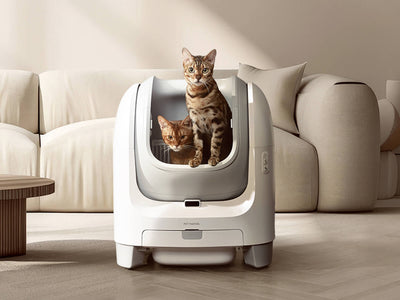Cats' reluctance to drink water is a common annoyance for pet owners. Cats may ignore the water bowl, but are curious about the water in the toilet and your cup. This seemingly “confusing” behavior is actually closely related to the cat's evolutionary instincts and physiology. This article delves into the science behind cats' hydration habits, and provides evidence-based strategies to encourage cats to drink more water.
Why Are Cats Naturally Reluctant to Drink Water
1. Evolutionary Legacy: Food as a Water Source
Domestic cats are descended from African wildcats, which get most of their water from prey (70% water). Modern cats have retained this instinct, prioritizing water-rich food over direct drinking.
Scientific support: Studies have shown that 80% of the water intake of wild cats comes from food, and only 20% from drinking water.

2. Physiological Traits: Delayed Thirst Response
- Humans: Thirst signals trigger at 2% dehydration (dry mouth, dizziness).
- Cats: they can tolerate up to 30% dehydration before feeling thirsty. Their kidneys conserve water by concentrating urine, but this puts a strain on kidney health and increases the risk of chronic kidney disease (CKD).
Data Insight: More than 60% of cats over 15 years of age develop kidney problems associated with chronically low water intake.
3. "Safe Water" Instinct: Preference for Movement and Freshness
Cats believe that stagnant water may not be safe (wilderness survival instinct). They tend to prefer running or freshly poured water, such as from a faucet or toilet.

4. Short-Term Memory Limitations
Cats can easily forget if they've had a drink of water, just as humans wonder if they've locked the door. The strategic placement of multiple drinking stations can stimulate a cat's curiosity to “rediscover” water.
4 Science-Based Strategies to Boost Hydration
Strategy 1: Hydrate Through Food—Wet Food Is Key
- High-hydration diets: Choose wet foods that contain ≥75% water (e.g., chicken-based rabbit or quail recipes).
- Hydrating Snacks: Soak freeze-dried snacks in broth or water.
- Broth Ice Cubes: Freeze low-sodium chicken or fish broth to boost your cat's hydration during the summer months.

Strategy 2: Leverage Running Water—Choose the Right Fountain
Cats are instinctively drawn to moving water. Research indicates water fountains can increase drinking by 50%.
Product Tips:
- Quiet operation: Choose a waterer with a noise level of less than 25dB (e.g. F2 V2).
- Multi-stage filtration: removes impurities and odors.
- Adjustable flow: Use waterfall or bubbling mode to simulate a natural stream.
- Use: Keep fountains away from litter boxes and food areas; clean pumps weekly.

Strategy 3: Freshness Matters—Daily Refreshments and Multiple Stations
-Multiple Water Stations: Place bowls in high-traffic areas (windowsills, hallways).
- Change water daily: Change bowls 1-3 times per day, especially in warmer months.
- Variety of containers: Try glass, ceramic or stainless steel bowls - some cats prefer to “steal” water from human cups.
Strategy 4: Sensory Engagement and Playful Incentives
- Ice Lure: Add ice to the water bowl in the summer.
- Catnip spray: Tap catnip-infused water near the bowl to attract interest.
- Interactive toys: Combine play and hydration with watery puzzle feeders and snack crumbs.
Pitfalls to Avoid
❌ Forcing cats to drink water: forcing cats to drink water can cause disgust.
❌ Milk substitutes: most cats are lactose intolerant.
❌ Over-reliance on dry food: coarsely ground food contains only 10% water; balance with wet food.
Tailored Solutions for Common Scenarios

Conclusion: Work With Nature, Not Against It
Cats' hydration habits have evolved over thousands of years. By going with their instincts - through flowing water, freshness, and fun engagement - you can turn hydration from a chore into an adventure. Remember: If your cat starts swallowing a lot of water, it could be a sign of dehydration. Prevention is always better than cure!
Further Reading:
- Feline Nutrition: Essentials for Health and Longevity (American College of Veterinary Nutrition)
- ISFM Guidelines on Managing Chronic Kidney Disease in Cats


